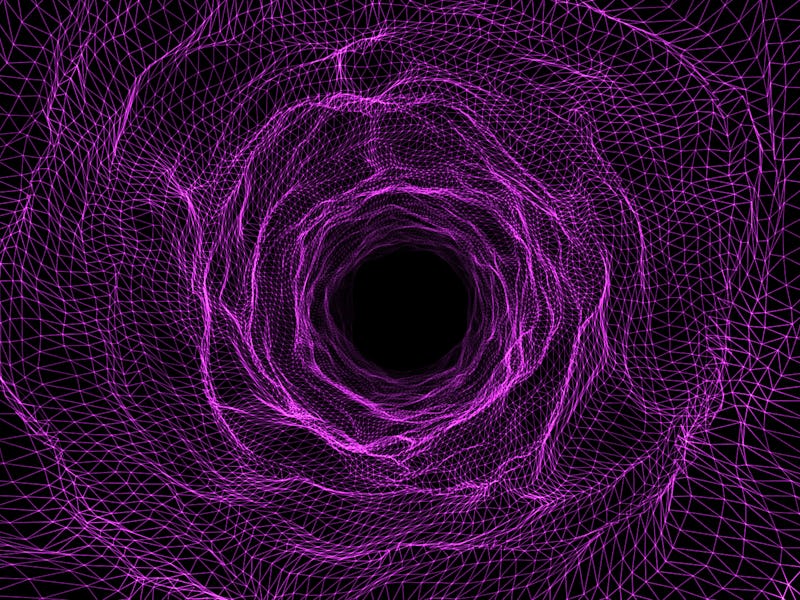Scientists may have solved a massive galaxy mystery
New observations could explain why star formation declines over time.

It’s been a banner time for black hole research: In recent months, astrophysicists have announced the discovery of the most powerful gamma-ray burst ever recorded (due to the formation of a black hole), a monster black hole in our cosmic backyard, the frame-dragging effects of a binary black hole, and the remains of the 2017 Kilonova event (spoiler alert: it was a black hole).
And with the help of citizen scientists, a team of astronomers recently discovered a unique black hole in a galaxy roughly one billion light-years away that’s hurling a relativistic jet at another galaxy.
The research was conducted by a team led by Ananda Hota, a researcher with the UM-DAE Centre for Excellence in Basic Sciences. The paper that describes their findings was published on October 12th in the Monthly Notices of the Royal Astronomical Society Letters.
Galaxies are typically divided into three main classes based on size, shape, and composition. First, there are ellipticals, which account for about one-third of all galaxies in the Universe that range from being nearly circular to very elongated.
A young elliptical galaxy viewed by Hubble.
Then there are spiral galaxies, which are noted for their distinct spiral arms and appear as flat disks with large yellowish bulges in their centers. Last, there are irregular galaxies, which are neither elliptical nor spiral and were more common in the early Universe (before evolving into the other two classes).
When it comes to elliptical galaxies, astronomers have observed that the formation of new stars is very scarce and appears to have largely ceased billions of years ago.
Space mysteries
While the reason for this remains a mystery, modern research suggests that the presence of supermassive black holes (SMBH) might be responsible.
These “monster black holes” cause the centers of massive galaxies to become Active Galactic Nuclei (AGN) — aka. Quasars — where the nucleus is more energetic than all the stars in the disk combined.
In many cases, AGNs also have massive jets spewing from their poles that accelerate gas and dust to relativistic speeds (close to the speed of light). The ejection of this matter toward other galaxies is believed to deplete elliptical galaxies of the cold gas and dust that would otherwise be fuel for star formation.
Another mystery facing astronomers is how these AGN-driven jets become coupled with the gas of merging galaxies, causing positive feedback. This temporarily leads to enhanced star formation, followed by negative feedback and a decline in star formation.
To address this latter mystery, Dr. Hota and his colleagues observed the SMBH at the center of RAD12, an elliptical galaxy located about 1 billion light-years from Earth.
This unique nature of this galaxy first became apparent in 2013 based on optical data from the Sloan Digitised Sky Survey (SDSS) and radio data from the Very Large Array’s (VLA) Faint Images of the Radio Sky at Twenty-Centimeters (FIRST) survey.
But when Dr. Hota and his team observed it again using the Giant Meter wave Radio Telescope (GMRT) in India, they noticed that RAD12 appeared to be ejecting matter from only one pole.
Illuminating observations
A jet of young plasma observed by Hota and his team.
These observations were confirmed using archival radio and optical data from the MeerKAT array in Australia and the Canada-France-Hawaii Telescope (respectively). Unlike other jets that eject matter in pairs and opposite directions, RAD12 appeared to be ejecting matter only toward its neighboring galaxy, RAD12-B.
Their observations also revealed a jet of young plasma that is conical in shape at the stem and flares out to become mushroom-shaped at the end (shown above). The yellow features represent galaxies — the larger being RAD12 (left) and RAD12-B (right) — and the plasma jet is shown in red.
The whole structure extends for 440,000 light-years and is much larger than the host galaxy itself. This is the first time a jet has been observed to collide with a large galaxy like RAD12-B. As Dr. Hota said in a recent Royal Astronomical Society (RAS) news release:
“We are excited to have spotted a rare system that helps us understand radio jet feedback of supermassive black holes on star formation of galaxies during mergers. Observations with the GMRT and data from various other telescopes such as the MeerKAT radio telescope strongly suggest that the radio jet in RAD12 is colliding with the companion galaxy. An equally important aspect of this research is the demonstration of public participation in making discoveries through the RAD@home Citizen Science research collaboratory.”
Thanks to the observations by Dr. Hota and his team, astronomers are now one step closer to understanding the impact that such interactions have on elliptical galaxies.
Their findings could lead to a new understanding of how star formation is arrested in elliptical galaxies, resolving a long-standing mystery about galactic evolution.
It is also a testament to the kind of research that is possible today through collaboration between citizen scientists and astronomers.
This article was originally published on Universe Today by MATT WILLIAMS. Read the original article here.
This article was originally published on